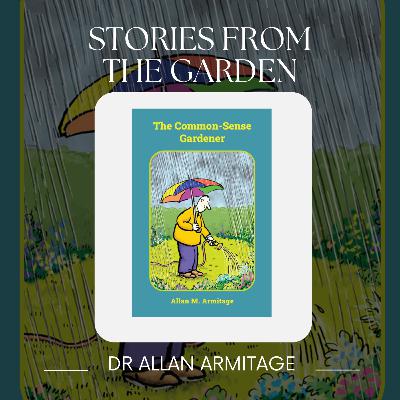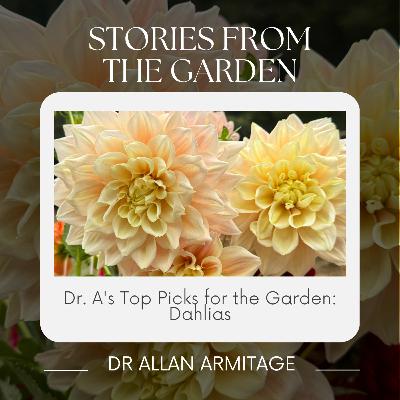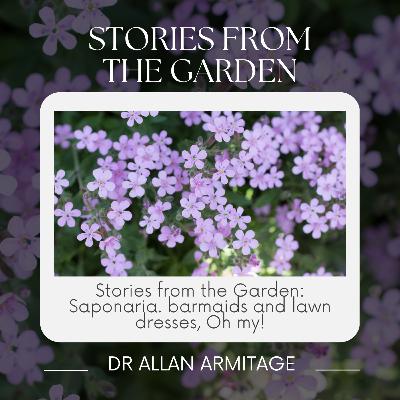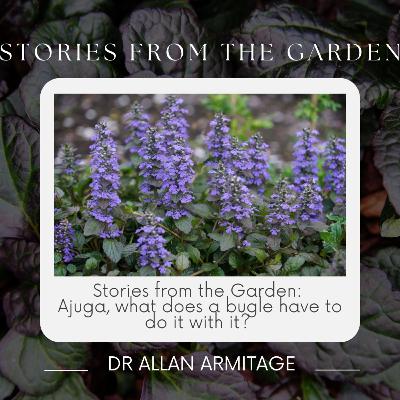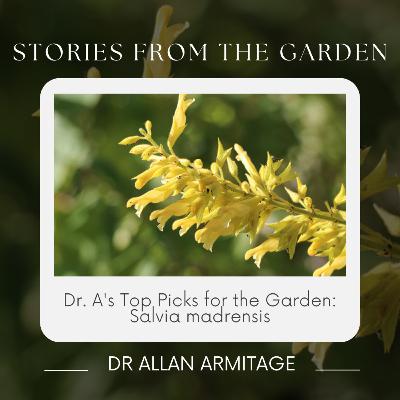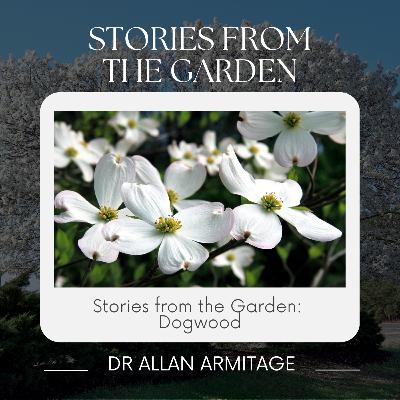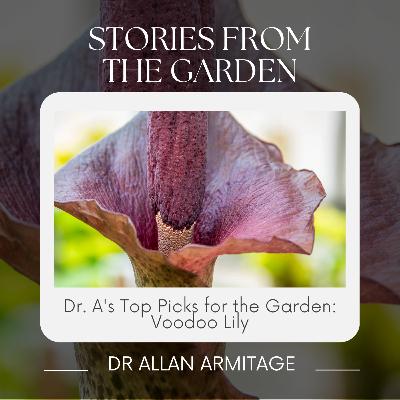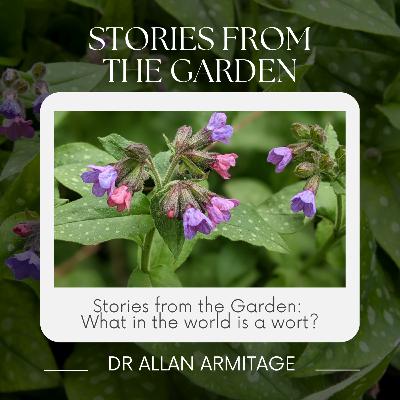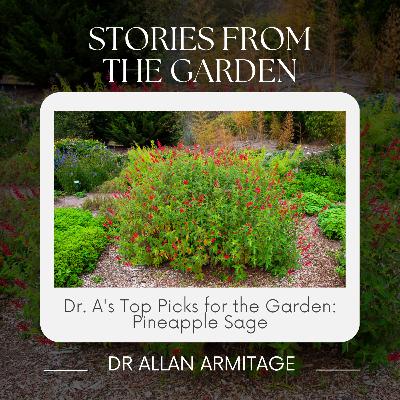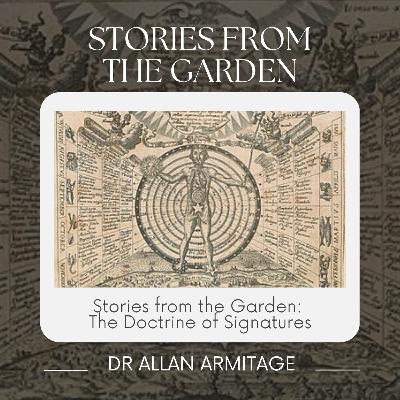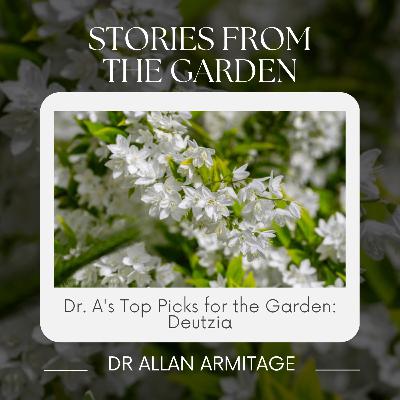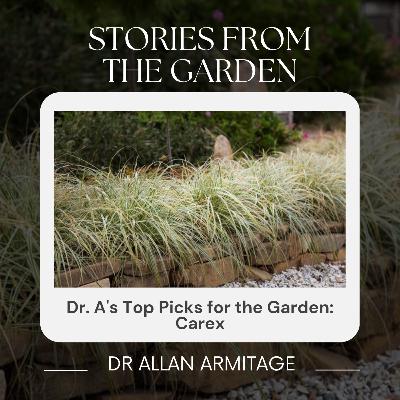Discover Stories from the Garden
Stories from the Garden

Stories from the Garden
Author: Dr. Allan Armitage
Subscribed: 6Played: 97Subscribe
Share
© Dr. Allan Armitage
Description
Gardening is not brain surgery or rocket science. There is so much more to our gardens than
compost and digging holes. The plants we garden with are story machines, each begging to be
heard.
Each week, sit back and listen to award-winning author and internationally acclaimed horticulturist Dr Allan Armitage as he talks about the “rest of the story.” For example, was there really someone called Joe Pye, and how did the poppy become the flower of remembrance?
Find a little time in your day for some storytelling to fire up your curiosity and learn something interesting to share with others.
compost and digging holes. The plants we garden with are story machines, each begging to be
heard.
Each week, sit back and listen to award-winning author and internationally acclaimed horticulturist Dr Allan Armitage as he talks about the “rest of the story.” For example, was there really someone called Joe Pye, and how did the poppy become the flower of remembrance?
Find a little time in your day for some storytelling to fire up your curiosity and learn something interesting to share with others.
33 Episodes
Reverse
Join beloved horticulturist, storyteller, and garden sage Dr. Allan Armitage for an exclusive first listen to his upcoming book The Common-Sense Gardener. In this special episode, Dr. A reads the opening chapters himself—infusing every anecdote, bit of wit, and piece of hard-earned wisdom with the warmth and humor only he can deliver.Pull up a chair, pour a cup of something warm, and settle in for a charming conversation between gardener and garden.Grab a your copy from November 15-December 15, 2025. They won't be available again until Spring 2026. www.allanarmitage.net
Everybody loves dahlias — in the garden, in a vase, or as a gift to a friend. But as Dr. Allan Armitage reminds us, these showstoppers aren’t always the easiest plants to please. In this colorful episode, Dr. A dives into the world of dahlias: how to start them from tubers, the best ways to get an early bloom, and what to do when winter rolls around.From the big, bold “show dahlias” that knock your socks off to the compact pot varieties brightening up garden centers, you’ll discover which types work best in your climate and how to keep them thriving year after year.
In this charming episode of Stories from the Garden, Dr. Allan Armitage takes us back to medieval Europe to uncover the fascinating history of soapwort—or Saponaria, as botanists know it. Ever wondered where early soaps came from, or how barmaids in old English inns kept their bottles sparkling clean? You’ll learn how this humble flowering plant became an essential part of daily life long before store-bought soap existed.From its etymological roots (what exactly is a “wort”?) to its surprising modern-day uses, this story bubbles over with wit, history, and a touch of garden magic. Tune in for a delightful blend of botany, folklore, and a few sudsy surprises along the way.
Whether you’re a casual gardener or a horticulture enthusiast, this episode will change how you look at mums — not as disposable decor, but as timeless treasures of autumn color. In this episode, Dr. A explores the often misunderstood world of mums—those bright, cheerful chrysanthemums that fill garden centers every fall. Are they simply “throwaway” plants, or can they be hardy perennials that return year after year?Join Dr. A as he reveals the myths and wonders behind these beloved flowers. You’ll learn how to identify which mums can truly endure, how to care for them after the fall season, and why these vibrant blooms deserve more respect in your garden.
In this episode, Dr. A digs into one of the most widely loved—and widely grown—ground covers in the garden world: Ajuga, also known as bugleweed. Found in gardens from north to south, ajuga is a true equal opportunist, spreading across landscapes with its striking foliage and beautiful lavender to blue flower spikes.But where did the name bugleweed come from? And what exactly is a bugleweed, anyway?Join Dr. A as he explores the history, beauty, and quirks of this versatile and colorful plant that’s just as fun to talk about as it is to grow.A favorite ground coverRich foliage in many colorsLavender-blue blooms
In today’s episode, Dr. A shares the story of one of his favorite salvias—a showstopping variety that many gardeners overlook. While salvias are well-known for their vibrant reds and blues and their ability to attract pollinators, this particular salvia steals the show in fall with its forsythia-like yellow blooms.Native to Mexico and found in gardens across the globe, this plant is more than just a pretty face. Commonly known as the Forsythia Sage, it flowers through the summer but truly shines in autumn. Tune in to learn why this underappreciated salvia deserves a spot in your garden—and maybe even your heart.Great for pollinatorsSpectacular fall colorA plant with a story, just like every good garden should have.
In this episode of Stories from the Garden, renowned horticulturist Dr. Allan Armitage digs into the curious connection between dogs and dogwoods. Ever wonder how the beloved flowering tree got its name? Spoiler alert: it’s not because dogs love to nap under them! With his signature wit and storytelling charm, Dr. A unearths the myths, history, and botanical surprises behind the dogwood's name.Whether you're a plant nerd, a casual gardener, or just someone who enjoys a good story, this episode is sure to make you see dogwoods—and maybe dogs—a little differently.
If you really want to spark conversation in the garden, or possibly run people off from the smell, plant a Voodoo Lily. One of the more interesting plants you can pop in the garden, and will only show up after a few years (this one takes patience) it is well worth the show, but maybe not the smell!
A wart, you say? No! A wort! In this episode of Stories from the Garden, we step into the quiet hum of an ancient herb patch, where folklore and botany intertwine. Journey with us as we uncover the forgotten wisdom of the "worts"—old-world medicinal plants like St. John’s Wort, Lungwort, and Spiderwort—whose names and uses tell stories older than science.
Sages, often referred to as salvias, are abundant, and there are countless varieties. You’ll never be able to grow them all or learn every single one, so don’t stress about it. However, today I want to recommend a very common variety: pineapple sage.
The common names of plants often seem to have no rhyme or reason. While some of these common names come from folklore, often with little basis in today's reality, others are the result of theological and herbal studies. There are numerous books on how plants produce great herbs and how herbs can treat various diseases. But where does this come from? Dating back to 40 AD, we can trace these ideas to the Doctrine of Signatures. Listen wherever you get your podcast or at my website:
Discover the beauty and charm of Deutzia, the perfect shrub for enhancing larger gardens. Let's explore its unique features and benefits together today!
Today, I'd like to introduce you to some of my favorite plants that are often overlooked. This group of plants, the sedges, is botanically known as Carex. My favorite being 'Feather Falls' .
This week in Stories from the Garden, I'm excited to dive into my absolute favorite plant, so special that I even wrote a book about it! Grab a cup of coffee and put on your favorite gardening gloves as I explore the incredible reasons why Lycoris deserves a special spot in your garden. Trust me, you’ll find it truly enchanting!
Today, I want to share a story about a common plant known as Dame's Rocket. Some of you may love it, while others might have grown to dislike it. Dames Rocket can be found abundantly in certain areas, particularly in the Midwest, Northeast, and parts of Southern Canada. It seems to be everywhere. This plant is known for its spectacular evening fragrance, and its botanical name is Hesperis.
To celebrate Canada Day, I have taken just a few minutes to discuss a brief history of Canadian independence and more! Raise a flag for all the Canucks in your life!
Today, we're going to discuss a plant that I'm not sure you'd want in your garden. Its common name makes it obvious why you may not want to include it, as it is a pretty native woodland plant, albeit a common one. This is a plant • called Bainberry. • And as soon as you hear the term ~ bane, it probably means that you don't want to be eating a whole lot of this stuff.
Today, I want to discuss a common garden plant called Lamb’s Ears (Stachys). It’s an effective edging plant that allows other colors to shine. Its soft foliage makes it a cozy and pleasant plant to talk about or share with friends.The name “Lamb’s Ears” is quite obvious, as it resembles the soft texture of a lamb’s ear. Early horticulturists and botanists likely felt the plant’s softness and named it accordingly. While I haven’t been close to lamb’s ears, I’ve been close to lamb’s wool, and I think the name fits well.
I highly recommend these to anyone willing to listen. If you're looking for one more reason to shop around for a Japanese Maple or need to persuade someone else, enjoy today's episode and feel free to share it with a friend.
Sharing a successful plant with others is truly rewarding. A beautiful plant not only enhances the aesthetics of your garden but also attracts pollinators and is native to the area. This morning, I want to highlight the yellow or golden coneflower, commonly known as Rudbeckia. Rudbeckia is native to a significant portion of the American landscape. Interestingly, Linnaeus named it during the development of binomial nomenclature in taxonomy. This plant is an excellent choice, and there are many varieties that would be perfect for your garden.


